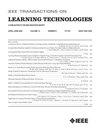Enhancing Sand-Table-Based Incident Command Training With Extended Reality and Interactive Simulations: A Use Case in Forest Firefighting
IF 2.9
3区 教育学
Q2 COMPUTER SCIENCE, INTERDISCIPLINARY APPLICATIONS
引用次数: 0
Abstract
In recent years, first responders have faced increasing challenges in their operations, highlighting a growing need for specialized and comprehensive training. In particular, the firefighting incident commanders (ICs) are playing a pivotal role, providing directions to field operators and making critical decisions in emergency situations. Over time, traditional training tools in this field have evolved, reaching their pinnacle with augmented sand tables (ASTs). ASTs build on spatial augmented reality (SAR), a form of extended reality (XR) that utilizes projections. Although ASTs enable large-scale visualization of the morphological features of the terrain, by relying solely on SAR, it is not possible to fully leverage the potential of XR, which is increasingly recognized as a powerful tool for training. This work introduces a novel approach to training ICs by integrating ASTs with XR, incorporating a learning-by-doing methodology alongside an objective measurement of trainees' performance. To this end, an XR training system (XRTS) has been developed, combining the capabilities of an AST with personal mixed reality devices and integrating a physically accurate interactive fire simulator. This system was deployed within a forest firefighting IC training course. All the system components were designed based on the theoretical foundations of decision making to effectively develop the necessary skills. The proposed approach was compared with traditional AST-based training methods for these roles, focusing on the analysis of learning outcomes, user experience, usability, and cognitive load. The study demonstrated several advantages associated with the use of the XRTS, including improvements in training effectiveness and a notable reduction in overall cognitive load.求助全文
约1分钟内获得全文
求助全文
来源期刊

IEEE Transactions on Learning Technologies
COMPUTER SCIENCE, INTERDISCIPLINARY APPLICATIONS-
CiteScore
7.50
自引率
5.40%
发文量
82
审稿时长
>12 weeks
期刊介绍:
The IEEE Transactions on Learning Technologies covers all advances in learning technologies and their applications, including but not limited to the following topics: innovative online learning systems; intelligent tutors; educational games; simulation systems for education and training; collaborative learning tools; learning with mobile devices; wearable devices and interfaces for learning; personalized and adaptive learning systems; tools for formative and summative assessment; tools for learning analytics and educational data mining; ontologies for learning systems; standards and web services that support learning; authoring tools for learning materials; computer support for peer tutoring; learning via computer-mediated inquiry, field, and lab work; social learning techniques; social networks and infrastructures for learning and knowledge sharing; and creation and management of learning objects.
 求助内容:
求助内容: 应助结果提醒方式:
应助结果提醒方式:


